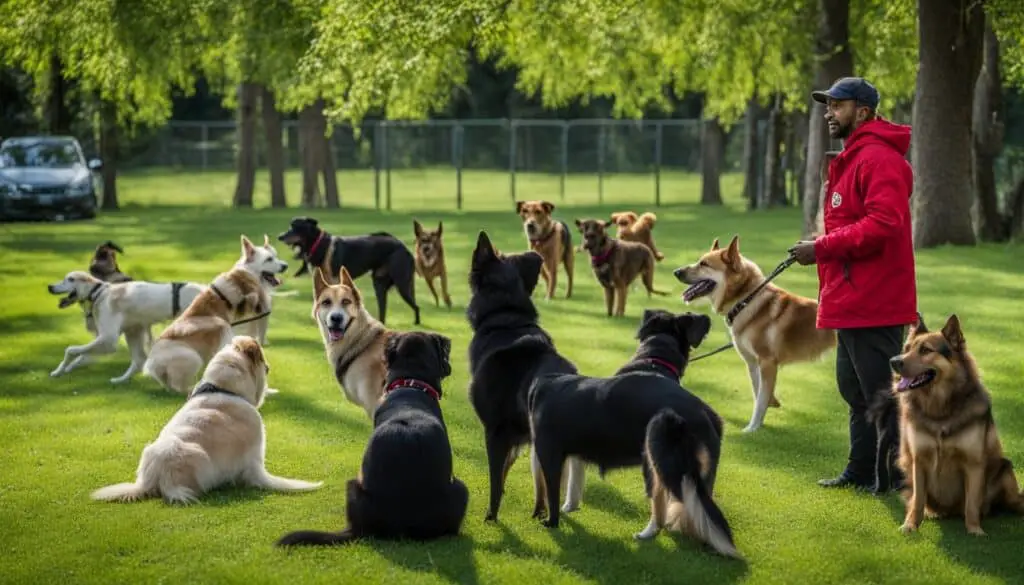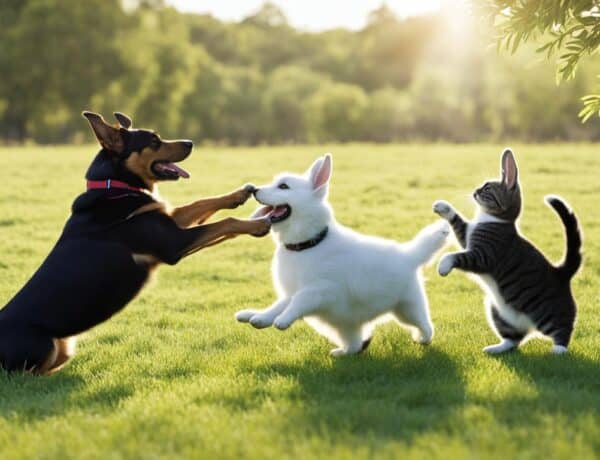When I adopted my pet from a shelter, I knew that behavioral training would be essential for their successful integration into my home. Whether you’ve adopted a dog or a cat, effective training techniques can make all the difference in helping them adjust to their new environment and become well-behaved companions.
Behavioral training for adopted pets focuses on teaching them appropriate behaviors, addressing any anxiety or fear-related issues, and establishing a strong bond between you and your new furry friend. By dedicating time and effort to training, you can help your pet thrive in their new home.
Key Takeaways:
- Behavioral training is crucial for adopted pets to adjust to their new home.
- Patience and consistency are key when training adopted pets.
- Creating a safe and comfortable environment helps in the training process.
- Positive reinforcement techniques are effective for teaching desired behaviors.
- Bonding and socialization are important aspects of training rescue pets.
Tips for Welcoming Your Rescue Dog at Home
Bringing a rescue dog into your home is an exciting and rewarding experience. To ensure a smooth transition and help your new furry friend feel safe and comfortable, there are a few important tips to keep in mind:
- Give them time to adjust: Understand that rescue dogs may have had challenging experiences in the past. Allow them the time and space to acclimate to their new surroundings at their own pace.
- Establish a routine: Dogs thrive on routine and structure. Creating a predictable daily schedule, including feeding, exercise, and bathroom breaks, can provide stability and help your rescue dog feel secure.
- Maintain consistency: Consistency is key when welcoming a rescue dog. Keep their environment and daily routines as consistent as possible to avoid confusion and make them feel more at ease.
- Avoid reinforcing unwanted behaviors: While it’s natural to want to shower your new dog with affection, avoid coddling or reinforcing any unwanted behaviors. Instead, focus on positive reinforcement for good behavior.
- Introduce crate training: Crate training can be beneficial for both safety and comfort. Ensure the crate is welcoming and never used as a form of punishment. Gradually introduce your dog to the crate by making it a positive and comfortable space for them.
Supervision is crucial during the first few weeks to prevent any accidents or mishaps and to build a bond of trust with your rescue dog. Additionally, consider enrolling in an obedience program or working with a professional dog trainer to set boundaries and establish good behavior from the start.
Remember, every rescue dog is unique, and it’s essential to be patient, understanding, and empathetic. With time, love, and proper guidance, your rescue dog will become a cherished member of your family.
| Benefits of Welcoming Your Rescue Dog | Challenges to Overcome |
|---|---|
| 1. Providing a loving home to a deserving pet | 1. Potential behavioral issues due to past experiences |
| 2. Developing a strong bond and sense of companionship | 2. Fear or anxiety in new environments |
| 3. Gaining a loyal and grateful lifelong friend | 3. Socialization difficulties with other animals |
| 4. Encouraging responsible pet adoption | 4. Patience needed to work through any challenges |
Building a Strong Foundation with Training
To train your rescue dog effectively, it’s important to start with a strong foundation. Using positive reinforcement techniques and clear communication, you can establish a bond of trust and respect with your furry companion. By implementing the following key strategies, you will pave the way for successful training and a harmonious relationship.
Positive Reinforcement: Rewards and Marker Words
Positive reinforcement is a powerful tool in training your rescue dog. By rewarding desired behaviors and using marker words, you can communicate clearly and motivate your dog to repeat those behaviors. Whether it’s a tasty treat, a favorite toy, or verbal praise, rewards help strengthen the connection between the behavior and the positive outcome.
“Good boy!”
“Great job!”
“Here’s a treat!”
Remember, consistency is key in reinforcing good behavior. Using marker words like “Yes!” or “Good!” signals to your dog that they have done something right, providing instant feedback and reinforcing the desired action.
Teaching Essential Cues for Safety and Manners
As you build a strong foundation with your rescue dog, focus on teaching them essential cues for safety and good manners. Reliable recall is crucial for off-leash control and ensuring your dog’s safety in various situations. Train them to come to you when called, using positive reinforcement and gradually increasing distractions under controlled conditions.
The “wait” cue is another important command that promotes safety and manners. Teaching your dog to wait patiently before crossing the road, entering or exiting doors, or receiving meals helps prevent accidents and establishes boundaries.
The “leave it” cue is valuable in preventing your dog from engaging with potentially harmful or unwanted objects or substances. Use positive reinforcement to redirect their attention and reward them when they choose to disengage from the item of interest.
Downtime and Leash Behavior
Rescue dogs, especially those who have experienced trauma or uncertainty, may benefit from learning how to relax during downtime. Teaching them to settle in a designated spot and providing them with a comfortable bed or crate allows them to decompress and find solace in a safe space.
Additionally, proper leash behavior is important for your dog’s safety during walks. Teach them not to pull or lunge, using positive reinforcement to reward loose leash walking. Leash training establishes clear expectations and makes the experience more enjoyable for both you and your dog.
Potty Training and House Rules
One of the top priorities in training your rescue dog is potty training. Consistent bathroom breaks outdoors, particularly after meals and naps, paired with positive reinforcement, will help them understand where and when it’s appropriate to relieve themselves.
Establishing house rules is equally important to prevent unwanted behavior. Set boundaries from the beginning and consistently reinforce them with positive reinforcement. Whether it’s not jumping on furniture, not begging for food, or not chewing on household items, clear expectations will aid in creating a harmonious living environment.
By building a strong training foundation with positive reinforcement, teaching essential cues, promoting good leash behavior, and establishing house rules, you are setting the stage for a well-behaved and content rescue dog. Consistency, patience, and love will further nurture your bond and yield fruitful results in your training journey.
Overcoming Challenges with Rescue Dogs
Bonding and socialization play a crucial role in the successful training of rescue dogs. Before diving into formal obedience classes, it’s important to take the time to establish a strong bond with your furry friend. This foundation of trust will create a solid framework for effective training.
To ensure a smooth socialization process, gradually expose your rescue dog to various environments, people, and animals. However, remember to prioritize their comfort level and introduce new experiences at a pace that they can handle. This approach will help them become more confident and adaptable in different situations.
For rescue dogs with a history of stress or anxiety, crate training can be a valuable tool. Providing a secure and cozy space allows them to feel safe and protected, aiding in their overall well-being. It’s crucial to make the crate a positive and comfortable environment, so they view it as their own personal sanctuary.
It’s important to keep in mind that rescue dogs may come from different backgrounds and have unique experiences. Therefore, patience and realistic expectations are essential when approaching their training. Each dog has their own learning pace, and it’s crucial to offer them support and encouragement throughout their journey.
The Power of Love and Patience
“Building a strong bond with my rescue dog has been a rewarding experience. Through patience and love, we’ve both grown and learned together. It’s amazing to see the progress they make when given the chance to thrive in a supportive environment.”– Jessica Anderson, proud rescue dog owner
By focusing on bonding and socialization, you can help your rescue dog overcome challenges and thrive in their new home. Remember, the journey may have its ups and downs, but with dedication and a positive approach, you can create a strong and lasting connection with your four-legged companion.
| Challenge | Solution |
|---|---|
| Fear and anxiety | Gradual exposure to new experiences and crate training |
| Previous trauma | Patience and understanding, offering a safe and secure environment |
| Trust issues | Building a bond through positive reinforcement and consistent training |
Conclusion
Adopting a pet is an exciting journey filled with love and companionship. However, ensuring a happy and well-adjusted home life for your new furry friend requires proper training.
By following these essential behavioral training tips for adopted pets, you can help your new companion settle into their new home, establish a strong foundation, and overcome any challenges that may arise.
Remember to be patient, consistent, and always use positive reinforcement during the training process. With time, dedication, and love, you can shape your adopted pet into a cherished member of your family, providing them with a safe and nurturing environment for life.
FAQ
Is training important for adopted pets?
Yes, training is crucial for adopted pets. While some rescue dogs may already have some level of obedience training, others may need more guidance. It’s important to be patient and give your newly adopted pet time to adjust to their new home. Creating a predictable and comfortable environment, establishing boundaries, and enrolling in obedience classes can all help in training your adopted pet effectively.
What should I do to welcome my rescue dog at home?
When bringing your rescue dog home, it’s important to create a safe and comfortable environment for them. Give them time to adjust to their new surroundings and establish a routine to provide stability. Keep things consistent and predictable, avoid coddling or reinforcing unwanted behaviors, and introduce crate training as a positive experience. Supervise your dog to prevent any accidents or mishaps and consider attending an obedience program to set boundaries and establish good behavior from the start.
How can I build a strong foundation with training?
To train your rescue dog effectively, it’s important to start with a strong foundation. Use positive reinforcement techniques and establish clear communication with marker words and rewards. Teach your dog reliable recall, the “wait” cue for safety and manners, and the “leave it” cue for disengagement. Additionally, ensure your dog is comfortable with downtime and teach them good leash behavior. Potty training should also be a priority, with consistent outdoor breaks and positive reinforcement. Finally, set boundaries from the beginning to reinforce house rules and prevent unwanted behavior.
How can I overcome challenges with rescue dogs?
Bonding and socialization are important aspects of training rescue dogs. Take the time to build a strong bond with your dog before introducing formal obedience classes. Gradually socialize your dog to different environments, people, and animals, taking their comfort level into consideration. Crate training can help them feel secure, especially if they have a history of stress or anxiety. Remember that rescue dogs may have different backgrounds and experiences, so it’s crucial to approach their training with patience, realistic expectations, and love.
Why is proper training important for adopted pets?
Adopting a pet is an exciting journey, and proper training is essential for creating a happy and well-adjusted home life. By following these behavioral training essentials for adopted pets, you can help your new companion settle into their new home, build a strong foundation, and overcome any challenges. Remember to be patient, consistent, and always use positive reinforcement. With time, dedication, and love, you can ensure that your adopted pet becomes a cherished member of your family.







No Comments